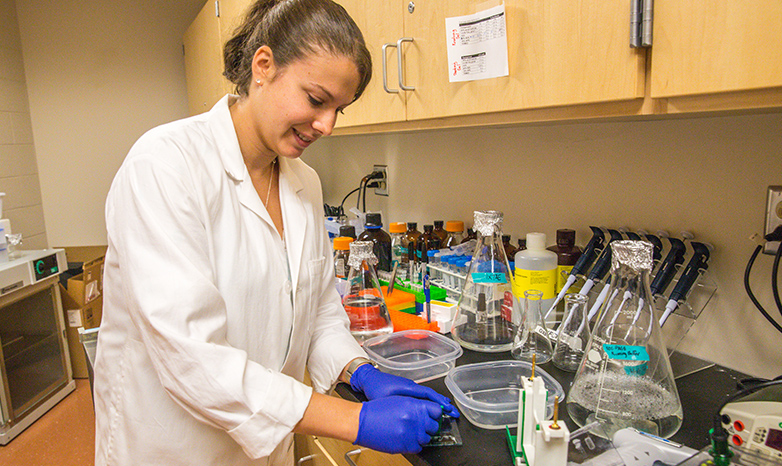SRU biology major conducting new soybean plant research

Emily Reed, a junior biology major from Volant, is studying the cell functions in soybeans thanks to a Summer Undergraduate Research Experience grant.
July 31, 2071
SLIPPERY ROCK, Pa. - The United States, as the world's largest producer of soybeans, has nearly 90 million acres devoted to the crop, according to the most recent outlook published by the U.S. Department of Agriculture. The most interesting soybeans however, could very well sprout up in a greenhouse at Slippery Rock University's Vincent Science Center.
Emily Reed, a junior biology major from Volant, received a $725 Summer Undergraduate Research Experience grant this summer to study the cell functions in soybeans. Under the guidance of Nicole Dafoe, assistant professor and chair of the biology department, Reed is observing "endoreduplication" in soybean plants. Endoreduplication is a cell cycle in which a cell's DNA is replicated, but the cell does not divide.
This process occurs in all organisms because of a specific gene called ccs52, or Cell Cycle Switch 52. All organisms have one of these genes, with plants having two or three, but soybeans are different.
"We started looking into soybeans and it turns out they have six of them, which is huge," said Dafoe, who made the discovery two years ago. "Research has been done with other organisms but there's not a ton out there on what we are doing. Nothing has been done in soybean. This is all very new."
Reed and Defoe may want endoreduplication to occur so they can learn from it, but what about farmers and, ultimately, consumers?
"There's both good and bad to it," Dafoe said. "Endoreduplication in plants has been associated with crop production and it's important for drought tolerance. While there are a lot of really good things that it's associated with, the downside is its association with pest and pathogen growth because of the nutrients on which they are able to feed."
Part of the research is testing different compositions of the gene, based on amino acid sequences, and how they contribute to endoreduplication.
"That's the exciting thing about endoreduplication - it occurs in lots of different phases," said Dafoe, who prior to coming to SRU five years ago was a research molecular biologist at the USDA. "It occurs during fruit development, it occurs in response to drought, it can occur in response to a pest feeding on it."
In soybeans, endoreduplication occurs when a swelling of cells, or nodules, are formed in response to the presence of nitrogen-fixing bacteria.
That's where Reed comes in. She is testing the effects of the ccs52 gene in yeast, as a model, as well as planted soybean to determine what is necessary to develop the nodules. The soybean plants are treated with bacteria when they are planted and some are grown in the absence of nitrogen.
Reed has spent two to three days per week in the lab this summer, experience she says will be important not only for discovery but to build her resume for future research opportunities and entrance into a doctorate program.
"I was extremely excited to get this research grant because I learned that I really have a passion for research and this is making it so that I'm able to come in every week and do more and learn more," said Reed. The aspiring professor is already eyeing doctorate programs in molecular or cellular biology that will allow her to bypass a master's degree because of her undergraduate research.
Reed and Dafoe said their efforts this summer will help scientists better understand the causes of endoreduplication. They plan to publish the findings in a peer-reviewed journal or present at conferences next spring.
"It's been a lot of practice and learning to do things that I didn't even know were possible before," said Reed, referring to scientific functions like DNA replication and measuring protein expression in organisms.
MEDIA CONTACT: Justin Zackal | 724.738.4854 | justin.zackal@sru.edu

